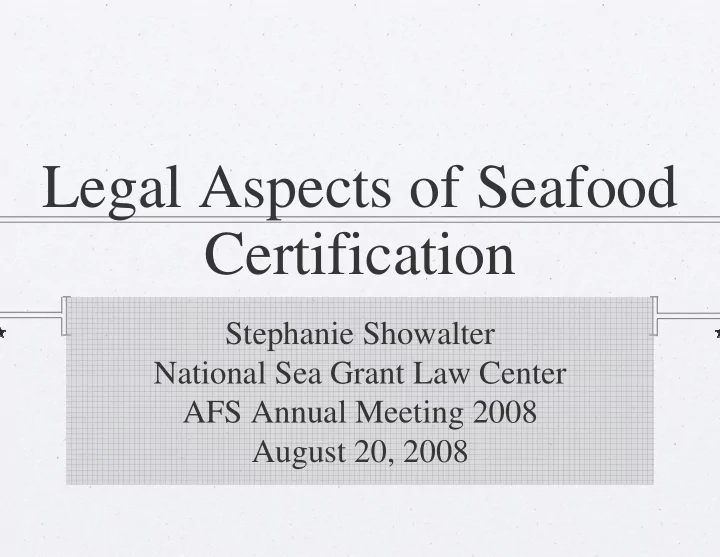

Legal Aspects of Seafood Certification Stephanie Showalter National Sea Grant Law Center AFS Annual Meeting 2008 August 20, 2008
Function of Trademarks dentify one seller’s goods and distinguish em from goods sold by others; gnify that all goods bearing the trademark ome from or are controlled by a single ource; gnify that all goods bearing the trademark e of an equal level of quality; and
Certification Marks Any word, name, symbol, or device, or any combination hereof that is Used by a person other than its owner, or which its owne has a bona fide intention to permit a person other than the owner to use in commerce To certify regional or other origin, material, mode of manufacture, quality, accuracy, or other characteristics o such person’s goods or services or that the work or labor the goods or services was performed by members of a un th i ti
Regional Origin
Regional Certification Marks Cannot be owned by any one producer or group of individual producers. An umbrella organization without an economic interest in product sales may own a mark used to certify geographic origin. In the U.S., this has typically been a governmental body or agency
Product Characteristics Certifiers of characteristics of goods and services of third parties offer a service - they provide a system to assure compliance with defined third-party standards. Consumers rely on UL mark as assurance that electrical equipment complies with the safety standards that UL sets.
Trademark vs. Certification ertification mark, unlike a trademark, is subject to cancellatio wner Does not control, or is not able to exercise control over, use mark Produces or markets goods on which the mark appears; Permits use of mark for purposes other than to certify; or Discriminately refuses to certify the goods of one who meet the standards the mark denotes. rademark owner controls nature and quality of the goods and ervices.
Trademark Infringement Results when any person uses in commerce any word, term, name, symbol or device, or any false designation of origin, false or misleading description of fact, or fals or misleading representation of fact, which Is likely to cause confusion as to the origin, sponsorship, or approval of his or her goods, services or commercial activities In commercial advertising or promotion, misrepresen the nature, characteristics, qualities, or geographic
Idaho Potato Comm. v. G & T Terminal Packaging 425 Fed. Rep. 708 (9th Cir. 2005). Idaho Potato Commission (IPC) sued G&T Terminal Packaging for infringement and breach of contract. G&T violated Lanham Act by purchasing bags bearing IPC’s certification mark and using them to package potatoes after G&T’s license to use mark had expired. Court awarded IPC $100,000 in statutory damages.
Piazza Seafood World v. Odom Piazza markets certain products under brand names “Cajun boy” and “Cajun Delight.” Commissioner of LA Department of Agriculture and Forestry argued that this infringed on “Certified Cajun-Product of Louisiana” mark No infringement - term “ j ” i j i f
Certification and Int’l Trade “Trade policy measures for environmental purposes should not constitute a means of arbitrary or unjustifiable discrimination or a disguised restriction on international trade. Unilateral actions to deal with environmental challenges outside the jurisdiction of the importing country should be avoided. Environmental measures addressing transboundary or global environmental problems should, as far as possible, be based on international consensus.” (Principle 12, 1992 Rio Declaration)
TBT Agreement WTO Agreement on Technical Barriers to Trade (TBT) Seeks to prevent members from using technical regulations or standards as disguised measures to protec domestic industries from foreign competition. Technical regulations are mandatory requirements for products or related process and production methods (PPMs) Standards are voluntary requirements for products or l t d PPM
Key Provisions Most Favored Nation and National Treatment obligations Members shall ensure that technical regulations and standards do not create unnecessary obstacles to trade. Encourages members to use existing international standards for their national regulations unless “their use would be ineffective or inappropriate” to fulfill a given policy objective. Members must ensure that standardizing schemes operated by national governmental or intergovernmenta
TBT and the Environment General Agreement on Tariffs and Trade (GATT) Article XX permits trade actions that are b) necessary to protect human, animal or plant life or health g) relating to the conservation of exhaustible natural sources if such measures are made effective in conjunction ith restrictions on domestic production or consumption. Preamble of TBT Agreement states: “No country should b prevented from taking measures necessary . . . for the protection of human, animal or plant life or health, or the
TBT and Ecolabeling Voluntary labeling schemes do not appear in principle to contravene existing multilateral trade rules. 1991 Tuna Dolphin Decision of GATT Arbitration Pane Although U.S. import restrictions on tuna were found be GATT-illegal, the Panel accepted the U.S. voluntar “dolphin-safe” tuna labeling scheme. Voluntary label did not illegally restrict the sale of tun because tuna products could be sold without the label and any competitive advantage gained depended on
Ongoing Disagreement WTO member countries have right to set criteria for the way products are produced, if the production method leaves a trace in the final product. Cotton grown using pesticides leaving pesticide residue in cotton itself. Members currently disagree about process and production methods which leave no trace in the final product. Can’t tell whether a table has been produced from
Contact Information Stephanie Showalter National Sea Grant Law Center University of Mississippi Kinard Hall, Wing E - Room 256 University, MS 38677 (662) 915-7775 sshowalt@olemiss.edu http://www.olemiss.edu/orgs/SGLC/
Recommend
More recommend